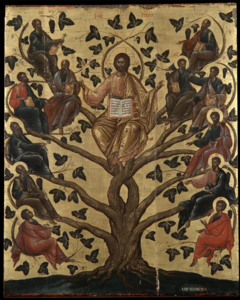
San Giorgio dei Greci is a church in the sestiere (neighborhood) of Castello, Venice, northern Italy. It was the center of the Scuola dei Greci, the Confraternity of the Greeks in Venice. Around this period there was a similar church in Naples called Santi Pietro e Paolo dei Greci. There was also a Greek Brotherhood of Naples.

Angelos Akotantos was a Greek painter, educator, and protopsaltis. He painted icons in the maniera greca, at a time when that style was moving away from the traditions of the Byzantine Empire and towards the more refined aesthetic of the Cretan School. Akotantos taught painting to Andreas Pavias, Andreas Ritzos, and Antonios Papadopoulos, and his style influenced later artists such as Georgios Klontzas, Theophanes the Cretan, Michael Damaskinos and El Greco. Angelos's brother Ioannis was also a famous painter. There are 50 extant paintings reliably attributed to Akotantos, 30 of which bear his signature.

The Crucifixion is a tempera painting by Andreas Pavias, who was active in Crete during the second half of the 15th century and is considered part of the Cretan School. It is now in the National Gallery of Greece. The painting influenced countless arts. Georgios Klontzas, Emmanuel Lambardos, Ioannis Moskos created similar works. Pavias introduced multiple figures to his Crucifixion. Georgios Klontzas began to employ a similar method in his famous work In Thee Rejoiceth. A work that was emulated by Theodore Poulakis and Franghias Kavertzas. The painting exhibited characteristics of the traditional maniera greca and the Venetian style.

Ilias or Elias Moskos was a Greek educator, shipping merchant and painter from Crete. The last name Moskos was associated with three famous painters of the Cretan School alive during the same period, along with Ioannis Moskos and Leos Moskos, possibly his relatives. Elias incorporated maniera greca with the Venetian style. Theodore Poulakis and Moskos brought the art and style of Crete into the Heptanese School of the Ionian Islands. Some of his work was inspired by Angelos Akotantos. He was affiliated with other artists such as Philotheos Skoufos. He is often confused with Leos Moskos. His son was not Ioannis Moskos although they were probably related. Elias most popular painting is Christ Pantocrator. Fifty-two of his paintings survived.

Konstantinos Tzanes was a Greek Renaissance painter. He was a painter in Crete and Venice. His brother Emmanuel Tzanes was the parish priest of the church of San Giorgio dei Greci. Emmanuel Tzanes was also a famous painter and author. Konstantinos followed the Venetian style and in some instances completely broke from the maniera greca. His other brother Marinos Tzanes was a famous poet. Konstantinos's work influenced both Greek and Italian Painters. His most popular work is the painting by Mary Magdalene which is at the Greek Institute in Venice.

Leo or Leos Moskos was a painter and educator. There were two other painters named Moskos active around the same period, Elias Moskos and Ioannis Moskos, who may have been his relatives. Indeed, Leo is often confused with Elias Moskos. Some of his work was inspired by Georgios Klontzas and Franghias Kavertzas. He traveled all over the Venetian Empire. Records indicate he traveled to Venice, Cephalonia, and Zakynthos His style resembled the Cretan School. He taught famous painter Panagiotis Doxaras. His most popular work is the Last Judgment. His paintings can be found all over the world. Twenty of his paintings have survived.

In Thee Rejoiceth also known as Epi Si Harri is a tempera and gold leaf painting by Georgios Klontzas. The painting is a tribute to the Virgin Mary. Klontzas was active on the island of Crete during the second half of the 16th century. He was a member of the Cretan School. He was one of the most prolific Greek painters of the 16th century. Most of his works were copied by other artists. The In Thee Rejoiceth painting was copied by countless Greek and Italian painters. Theodore Poulakis created a version in the 17 century that is very similar to Klontzas's In Thee Rejoiceth. Franghias Kavertzas also painted a similar theme. He called his painting In You Rejoices. Leos Moskos also created his version of the popular painting. The Klontzas painting is currently at the Hellenic Institute of Byzantine and Post-Byzantine Studies Museum in Venice.

The Last Judgment also known as The Second Coming is an icon by Georgios Klontzas. The painting is a depiction of the return of Jesus Christ. The Second Coming is believed to be the final and infinite judgment by God of the people of every nation resulting in the approval of some and the penalizing of others. This painting is a depiction of that event. Klontzas was a Greek artist from the island of Crete. His artistic output was during the second half of the 16th century. He was affiliated with the early works of El Greco. He was one of the most productive Greek painters of the 16th century along with Michael Damaskinos. Klontzas was a member of the Cretan School. Most of his works were copied by other artists. His version of the Second Coming was used as a framework for other artists during the Late Cretan School. Leos Moskos and Francheskos Kavertzas both created similar versions.

The Last Judgment also known as The Second Coming is an egg tempera painting by Francheskos Kavertzas. His artistic period was during the first part of the 17th century. Seven of his works survived, five were signed. He was a member of the late Cretan School. The Last Judgment painted by Georgios Klontzas inspired countless Cretan artists, Kavertzas was one of them. Kavertzas's painting In You Rejoiceth strongly resembles Klontzas's In Thee Rejoiceth. Leos Moskos was also inspired by Klontzas's work. He also painted a similar version of The Last Judgment. The final judgment is the last judgment of every person on earth. The painting is a pictural representation of that event. The Kavertzas The Last Judgment is unique because it features a nun. Her name was Evgenia Trapezontiopoulla. According to records on March 9, 1641, the nun could not afford to pay for the painting. Kavertzas and the nun bartered instead. The painting is part of the collection of the Hellenic Institute of Venice in Italy.
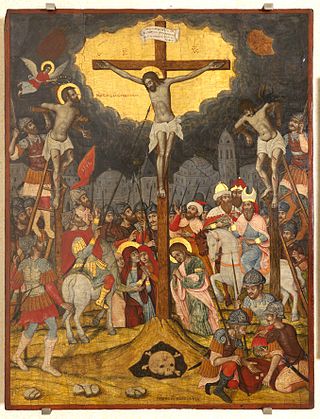
The Crucifixion is an egg tempera painting created by Ioannis Moskos. Moskos was a Greek painter originally from Crete. He migrated to Venice. Two other painters named Moskos were active during the same period. Their names were Elias Moskos and Leos Moskos. Leos and Ioannis were both in Venice during the same period. Ioannis was a member of the Late Cretan School. He was active from 1650 to 1721. Forty-four of his paintings survived.

The Crucifixion is a painting created by Georgio Markazini. Markazini was a Greek painter from the island of Crete. He migrated to Venice. He was active during the middle part of the 17th century. Two of the painter's works survived. The crucifixion was a very popular subject among Cretan painters. Andreas Pavias, Emmanuel Lambardos, and Theophanes the Cretan created a similar style crucifixion. The Cretan painters frequently influenced each other.
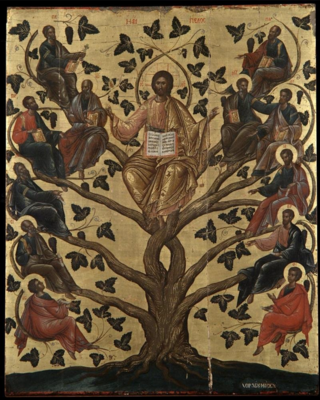
Christ the Vine, also known as the Tree of Christ, is a tempera painting by Leos Moskos. Moskos was active from 1620 to 1690. Twenty of his works have survived. He was originally from Rethimno, Crete. He traveled all over the Venetian empire. He worked on the Ionian islands of Cephalonia and Zakynthos. He also worked in Venice. Two other painters with the same last name were active during the same period. They were Elias Moskos and Ioannis Moskos. All three artists painted in the same style. Leos was in Venice around the same period as Ioannis. There is strong evidence that the three were related. Famous Greek painter and historian Panagiotis Doxaras was Leo’s student.
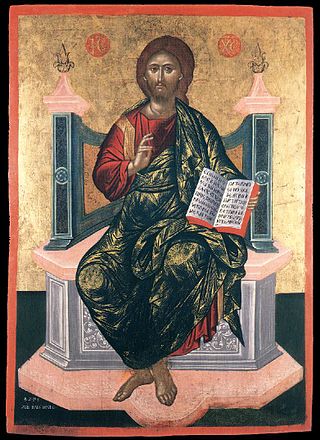
Christ Enthroned is a tempera painting by Elias Moskos, a representative of the Late Cretan School. The artist was also associated with the Heptanese School due to his migration to Zakinthos and the transition of his painting style. Moskos also taught painting. Most of his students became church committee members. Church committees were responsible for commissioning paintings. He was active from 1645 to 1687 on the islands of Crete, Zakynthos, and Kefalonia. Fifty-two of his works survived, over half of them were signed. Two other painters named Moskos were active during the same period Ioannis Moskos and Leos Moskos.

Christ Enthroned is a tempera icon by Emmanuel Tzanes, a Greek painter of the Late Cretan School. It is currently at the Byzantine & Christian Museum in Athens.
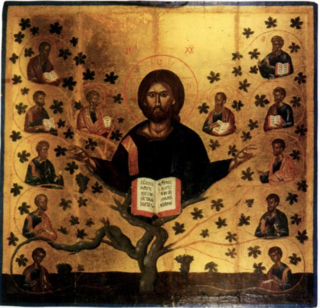
Christ the Vine is a tempera painting created by Greek painter Angelos. Angelos was active from 1425 to 1457. He was a teacher and protopsaltis. His students included some of the most famous painters of the early Cretan Renaissance. Andreas Pavias and Andreas Ritzos were his students and were heavily influenced by his style. Forty-nine of his works survived. Angelo’s Christ the Vine was one of his most important works.
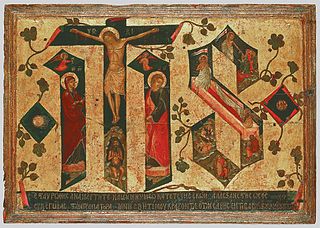
Jesus Hominum Salvator is a tempera painting by Andreas Ritzos. Ritzos was one of the founders of the Cretan School of painting. His teacher was Angelos Akotantos. Andreas Ritzos was active from 1436 to 1492. He painted in the traditional Greek-Italian Byzantine style combined with Italian Renaissance Venetian painting. The technique later became known as the maniera greca. Sixty of his works survived.

Noah's Ark is a tempera painting by Theodore Poulakis. Poulakis was a Greek Baroque painter and teacher. He was a member of both the Late Cretan School and the Heptanese School. He is often regarded as the father of the Heptanese School. He was active from 1635 to 1692. By the age of 24, he was living in Venice. He stayed in the city for thirteen years. He was involved in local politics. He frequently traveled all over the Ionian Islands and settled in Corfu. He also regularly returned to Venice. Over 130 of his paintings have survived and can be found all over the world.

Jacob’s Ladder is a tempera painting created by Elias Moskos. Elias was a Greek painter originally from the island of Crete. By the 1650s he was living on the island of Zakynthos. He also worked on the island of Kefalonia. There were two other painters active during his lifetime with the same last name. Ioannis Moskos and Leos Moskos. The painter was also a prominent teacher. He also had a sizable fortune. Fifty-two of his paintings survived. He represented the Cretan School and the Heptanese School. His works typically combine both schools. His work was heavily influenced by engravings from all over the world some were Flemish. His artistic activity ranged from 1629 to 1687. Most of his remaining works are in Greece and Italy.

The Nativity is an egg tempera painting by Victor. Victor is sometimes referred to as Victor of Crete. Victor was active from 1645 to 1696. He traveled all over the Venetian empire. He settled in Zakinthos. Some of his important works can be found in the church San Giorgio dei Greci in Venice. He is a very important Greek painter because of his existing catalog. His works of art exceed ninety-five paintings. One of his notable works was his version of Christ the Vine.

The Incredulity of Saint Thomas is a tempera painting created by Greek painter Emmanuel Tzanes. Tzanes features a catalog of artwork numbering over one hundred works. He was one of the most prolific artists of the 1600s painting in Crete, Corfu, and Venice. His two brothers Marinos Tzanes and Konstantinos Tzanes were also famous painters but Marinos is more well known for his famous poem The Cretan War Ο Κρητικός Πόλεμος. All three artists were members of the Late Cretan School and early Heptanese School (painting) they were known for participating in the movement that integrated Flemish engravings into the Greek and Italian art world.

